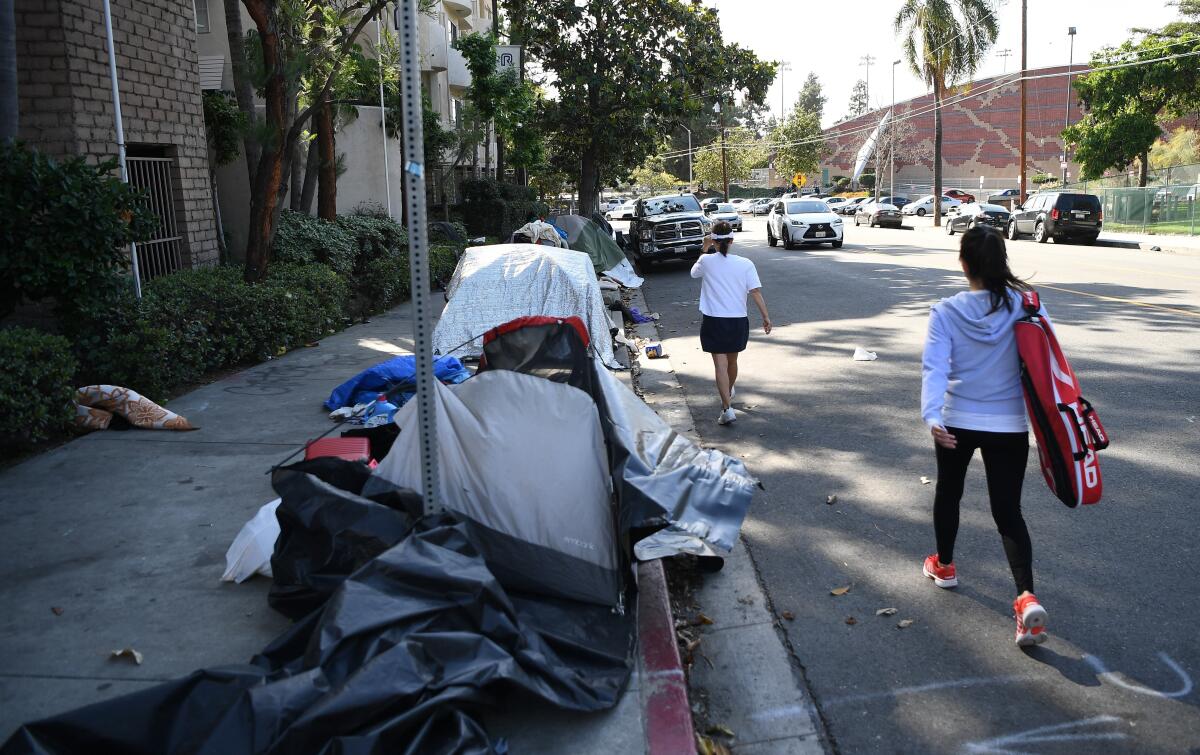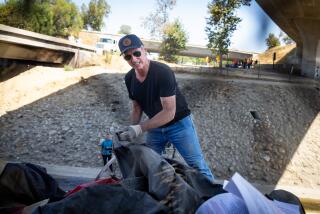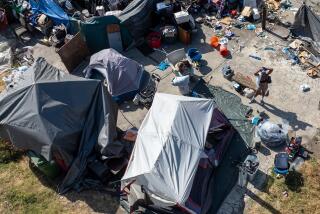Some L.A. officials want a state of emergency declared as homelessness crisis worsens

Facing a deepening quagmire over homeless encampments, Los Angeles elected officials are increasingly looking to sweeping statewide initiatives to shake loose solutions. The latest proposal from Los Angeles County Supervisor Mark Ridley-Thomas and City Councilman Joe Buscaino would have the governor declare a state of emergency on homelessness in California.
Supporters view such a declaration as a novel strategy to free up state and federal funding typically reserved for natural disasters, such as earthquakes or wildfires, and to suspend or streamline the regulatory hurdles that often slow down shelter and housing development. It also could block NIMBY opponents from using environmental reviews to sue and delay or block homeless facilities from opening.
But some question whether an emergency declaration would be merely symbolic, given President Trump’s rejections of more federal funding and Gov. Gavin Newsom’s commitment of $1 billion for local homeless programs and support for more regulatory relief.
Last week, Newsom signed a package of legislation that, among other things, exempts from environmental review supportive housing and shelter projects in the city of L.A. that receive funding from certain public sources, including the $1.2-billion Proposition HHH housing bond measure that voters approved in 2016.
Another new law allows cities in Alameda and Orange counties, in addition to the city of San Jose, to declare a shelter crisis so those local governments can eventually bypass some planning and zoning regulations to expedite construction.
“The governor should not sign a declaration of emergency until the proponents identify the specific laws and regulations they want to get around, and the resources they believe the declaration would free up,” said Gary Blasi, a retired law professor who specializes in homelessness issues. “The state statutes regarding emergencies were not designed to respond to long-standing political, leadership and moral disasters.”
Newsom has not taken a stand on the current request for a state of emergency declaration, and Alex Comisar, spokesman for Mayor Eric Garcetti, said it was “a choice for the governor to make.”
“There are more questions that need to be worked through before he could support something like that,” Newsom spokesman Nathan Click said.
In 2015, City Council members and Garcetti announced that they would declare an emergency locally, but then dropped the idea as the mayor sought a statewide declaration from then-Gov. Jerry Brown, who turned him down.
Then in 2018, Los Angeles declared a shelter crisis, which, along with a legislative change, triggered streamlining of red tape around developing emergency beds on public land.
Many in Los Angeles have been frustrated by the sluggish pace of construction of new shelters and housing for the estimated 44,000 residents in the county, including 27,000 in the city, who live outdoors in tents, cars or lean-tos, as opposed to shelters or other temporary housing. Only 477 emergency shelter beds have been added in the last 2½ years for households without children, which form the bulk of the homeless population, according to an inventory released this month.
Buscaino said he had grown particularly frustrated that even temporary tent shelters on public land had become bogged down in multiple approval processes.
“We’re stopping for every red light, instead of treating this like an emergency,” Buscaino said.
Before a meeting Friday of the governor’s task force on homelessness, headed by Ridley-Thomas and Sacramento Mayor Darrell Steinberg, Newsom, in a letter, asked members to prioritize getting people off the streets.
He underscored that local communities must “fully enforce” public safety and health laws, touching on the controversial issue of sanitation sweeps of encampments and other police enforcement. He also asked the task force for proposals to break down barriers to building housing and to get more homeless people into treatment.
Steinberg and Ridley-Thomas are championing a legal right to shelter for California, which would require local governments to provide a bed to every homeless person who wants to move indoors. Steinberg also wants to require homeless people to accept shelter if offered, although how that would be enforced remains a question.
Separately, several local governments — including the city and county of L.A. — and business groups also are petitioning the U.S. Supreme Court to hear a challenge to a federal appeals court ruling out of Boise, Idaho, that has stopped authorities in Western states from arresting homeless people for sleeping in public when shelter space is unavailable.
“We have a tacit public policy it’s OK to live outdoors,” Steinberg said. “I am strongly pushing for a clear public policy that says as a matter of right people should be living under a roof.”
Newsom has said he is not ready to endorse a legal right to shelter.
“What the governor has said is it’s urgent, let’s get started,” Ridley-Thomas said. “I don’t think anything is dead.”
Before the meeting in Willowbrook on Friday, Ridley-Thomas and Steinberg insisted they were not backing off. But Steinberg repeatedly emphasized that he preferred that people be placed in permanent housing, not a vast shelter system, which critics say could blow the state’s budget without ending homelessness.
“The hard reality is that the governor has already done most of what would be done if a state of emergency was to be called,” said Philip Mangano, the former federal homelessness czar in the George W. Bush and Obama administrations and a member of the governor’s task force. “The governor is the homelessness czar in California and the task force’s job is to give him big ideas to make a difference.”
Homelessness emergency declarations in other parts of the U.S. have a mixed record. Hawaii has issued multiple declarations, the last one in 2018, that have allowed the state to suspend permitting and site restrictions, shaving one to two years off shelter and housing projects, said Scott Morishige, the governor’s coordinator on homelessness.
State homeless numbers overall dropped last year, but the number of unsheltered people on Oahu rose 12%. An emergency declaration “is not a silver bullet by any means,” Morishige said.
In Oregon, Portland and the surrounding Multnomah County used an emergency declaration to relax occupancy rules and zoning for homeless projects.
“Shelters were set up in weeks instead of months or longer,” said Denis Theriault, spokesman for the office of homeless services for Portland and the county.
Theriault said the local homelessness budget also doubled, to $70 million over five years. In January, Multnomah County’s homeless count showed a decline of 4% from 2014, but the number of people living in tents or cars and under bridges was up 22% from the year before.
In California, Steinberg said, what is most important is stating a clear public policy that it is not OK for tens of thousands of people to be living outdoors.
“Everybody has a right to live under a roof — preferably in permanent housing, if necessary in navigation centers,” he said. “It starts with that acknowledgment.”
More to Read
Sign up for Essential California
The most important California stories and recommendations in your inbox every morning.
You may occasionally receive promotional content from the Los Angeles Times.











